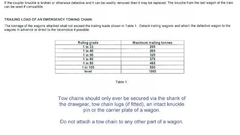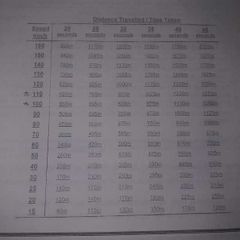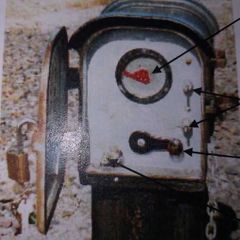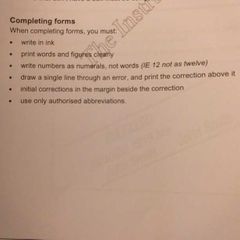![]()
![]()
![]()
Use LEFT and RIGHT arrow keys to navigate between flashcards;
Use UP and DOWN arrow keys to flip the card;
H to show hint;
A reads text to speech;
50 Cards in this Set
- Front
- Back
- 3rd side (hint)
|
If a train suddenly gets a strong air flow en-route what does it mean? |
Train has either broken away, derailed or developed an air leak. Train brakes will apply. |
|
|
|
What should your immediate actions be if a strong air flow starts? |
Power while possible to try and keep separated wagons from colliding with front wagons. Make Emergency Local & Control Radio calls if there are parallel lines and assume they are fouled. Inform control of circumstances. (If control cannot be contacted protect any parallel lines and attempt to stop rail traffic). Inform IPS of circumstances. Prepare to check for source of air flow. |
|
|
|
What should be done before walking back during a loss of air incident? |
Check Dangerous Goods information & Do a risk assessment. Collect everything needed; handheld radio, pen &paper, torch. If it cannot be confirmed with NCO rail traffic has been stopped on adjacent line bring dets, flags & track circuit shorting clips to protect line. Perform radio check with driver. |
|
|
|
Once source of air flow has been found what should be done? |
If derailed notify control immediately and await instructions. Obstruction & Train may need to be protected if control cannot be contacted or cannot confirm that rail traffic has stopped. If not check if repairs are needed and repair if possible. Record any wagon numbers affected. If possible shunt train back together, perform modified or full continuity. Pull whole train past 2nd person and check etm is in place. Complete incident report with IPS. |
|
|
|
When en-route if a particular section does not need all locomotives powering what is an easy way to conserve fuel? |
Take one engine offline. Either use consist monitor for NR or 93 classes or change power switch to start on lead locomotive. Note - If lead locomotive is set to start/isolate dynamic brake indication will not be displayed. |
|
|
|
On any train running job what should be recorded in a diary or notes? |
Departure time & Arrival Time. Times through notable locations. Reason & Length of Delays. Any safeworking procedures or incidents. Fuel levels at start and end of trip. Loco Numbers, train information. |
|
|
|
What is the difference between an Active & a Passive level crossing? |
Active - Protected by lights, bells &/or booms. Passive - Not protected by lights, bells or booms, generally a Stop sign. |
|
|
|
What are the speed/s for WOLOs if you are running a Super Freight (115kmph) train? |
VIC - 80kmph or Track Speed if lesser.
NSW - Maximum 80kmph. Or 10kms less than track speed to as low as 60kmph or track speed if lower.
Examples - Tullarmarine 95 would be 80. Albury 70 would be 60. McIntyre 65 would be 65. North Geelong 50 would be 50.
Note - Train control can dictate a speed lower than official WOLO speeds. |
|
|
|
What are the speeds for WOLOs if you're running a train with 80kmph wagons? |
VIC - 65kmph or track speed if lesser. 50kmph if consist contains any empty wagons. (Check)
NSW - If no empty wagons: A maximum of 80kmph or 10kmph less than track speed as low as 60kmph. (Same as Super Freight).
One or more empty wagons: Allowable track speed but not exceeding 50kmph.
Note - Train control can dictate a speed lower than official WOLO speeds. |
|
|
|
What are the speed/s for WOLOs if you're running a Passenger train or Light engine movement? |
VIC - 90kmph or track speed if lesser.
NSW - Maximum 90kmph. Or 10kms less than track speed as low as 60kmph. Note - Train control can dictate a speed lower than official WOLO speeds. |
|
|
|
What should be the minimum brake application made on a freight train? |
70kpa - Due to back of a long train sometimes not holding as much pressure. 50kpa reduction may not be enough to apply and release brake effectively. |
|
|
|
What Radio Channel/s are used for main line running? |
Local - V1 In Victoria, SRA WB in NSW. Note - Local button on Ice Radio will automatic set UHF 1 to local, automatically changes at Vic/NSW Border. |
|
|
|
NSW Only - When a safeworking form has been issued when should it be Fulfilled and when should it be cancelled and how is this done? |
Fulfilled - When All Instructions have been completed.
Cancelled - When some or none of the instructions have been completed.
Two diagonal lines with FULFILLED or CANCELLED, Name, Date, Time & Signature. |
|
|
|
What are your actions when you are told an ETM is turned not flashing or not visible after a roll by? |
Inform NCO & Stop at next possible location to arrange to have it replaced or turned on. If ETM is missing ALWAYS confirm last wagon number matches TMS to ensure train is complete. |
|
|
|
If shunting is required at Ettamogah or Bomen what should be done before arriving at the siding? |
Confirm with Junee B Board NCO as soon as practical. Contact Shunter/s to confirm they are ready. Know how the shunt will be done; Attach/Detach info, position in consist etc. |
|
|
|
What is the procedure for using the ground frames at Ettamogah and Bomen? |
1. Detach Locos (&Wagons) before fould point. 2. Bring last loco/wagon to stand on release circuit (18m long). 3. Unlock box, check release light. If lit, press release button, reverse lever and turn and remove Annette Key. 4. Use Annette key to unlock frame and reverse both point levers (left to right). 5. Shunt as needed, DO NOT close frame with Locos in siding. 6. Reverse point levers (right to left) to close and lock with Annette Key. 7. Replace Annette Key, return release lever to original position, & lock box with SL padlock. 8. Shunt train together and perform FC or MC, leakage etc. 9. Confirm with control new load details and permission to depart.
|
|
|
|
If an emergency tow chain must be used, what are the maximum trailing loads behind the tow chain depending on the grade? |

|
|
|
|
If required to stable train en-route how many handbrakes should be applied depending on the grade? |
1/32 or steeper - 100% 1/49 to 1/33 - 80% 1/50 to 1/99 - 50% 1/100 to level - 30% |
|
|
|
What are the steepest grades found on each of the main 3 PN Intermodal routes? |
Junee - 1/40 (several Wagga Wagga to Junee) Dimboola - 1/50 (several Maroona to Dimboola) Long Island - 1/50 (several) |
|
|
|
How should you record irregularities and faults to track infrastructure en-route? |
Contact NCO as soon as possible. Fill out an incident report for major faults & irregularities. |
|
|
|
How is your maximum permissible speed determined? |
Depending on location, the lowest of: Signal Idication Loco Speed Wagon Speed Turnout or Curve Speeds Speed Restriction (Permanent or Temporary). |
|
|
|
If stopped at a home signal what should be done? |
Contact NCO. State signal post #, train location & identity, train origin & destination. Inquire about reason and length of delay. If stop isn't timetabled or is excessive update IPS with details. |
|
|
|
If an active level crossing fails to operate on the outter circuit what must be done? |
Inform NCO if CAN hasn't been issued. Proceed cautiously on to inner circuit, stop, proceed when crossing is operating correctly. |
|
|
|
In Victoria what steps would you take to protect a parallel line from a potentially dangerous condition or derailment? |
Inform NCO and get them to stop all rail traffic. Make Emergency Local Radio Call from other handset. Until control is contacted and confirms all trains have been stopped initiate plan to stop trains. 1.Display red markers and red hand signal. 2. Apply Emergency Track Circuit cables 3. With red handsignal proceed 2kms from condition. 4. Use Emergency Whistle code on loco 5. Flash headlights between low and high beam. 6. Take any and all steps to stop approaching Rail Traffic. |
|
|
|
What is the whistle used for? |
To warn of your approach. - Road and Pedestrian Traffic - People working on or near the line - In Emergency situations |
|
|
|
When must the whistle be sounded? |
- Before moving loco/train. - Whistle Board. - Passing over a level crossing or ped crossing. - When approaching a station where no stop is scheduled. - Before entering a cutting or tunnel. - When approaching stationary train. - When propelling. |
|
|
|
How should marker lights be set up in Victoria? |
Lead loco - 2 whites at front. Shunt Loco - White on driver's side, red on co-driver's. Both ends. Trail loco of light engine consist - 2 reds at rear. No reds needed if attached to train with ETM. |
|
|
|
When stopped clear in a crossing loop in Victoria how should the marker lights be set up on the lead loco until the cross is complete? |
White on the side closest to the other running line. Red on the side furthest away. |
|
|
|
When should the headlight be dimmed en-route? |
Standing within station limits. When rail or road traffic is approaching. In yards where shunting locos are used. |
|
|
|
If a train needs to propel on a running line what must be assured? |
Confirm with control permission to set back or shunt. Ensure movement is preceded. Follow speed limits for propelling on a main line, depending on state. 15km victoria, restricted speed NSW (Max 25kms, 10 crossings) |
|
|
|
Under what circumstances may you need to propel a train on a running line? |
- Shunting. - Pushing a disabled train. - Pushing a train up a heavy gradient. - Pushing a train to/from an obstruction. - Setting back because of an obstruction on the track. - Special instructions issued by control. - A ballast or work train. |
|
|
|
If your ditch lights fail en-route what action should you take? |
As long as headlights and markers still work no operating restrictions apply. Log fault and contact help desk to attempt to rectify. |
|
|
|
If you notice/report any condition affecting the network what are your responsibilities? |
Report to NCO. Depending on situation you may be required to protect lines and attempt to stop other rail traffic approaching dangerous conditions until NCO has confirmed all rail traffic has been stopped. |
|
|
|
Under what circumstances can a CAN be used as a proceed authority? |
None. |
|
|
|
If you explode 1 ATW what are your actions? |
NSW & VIC - Sound one long horn, reduce speed and be prepared to stop short of any obstuction. Be prepared to find flagman protecting a signal (VIC) or obstruction. Contact NCO. *1 isn't indicative of anything in particular but could mean other ATWs have failed to detonate. |
|
|
|
If Required to walk the train and you need to walk on an adjacent track due to access what needs to be done first? |
Contact control and ask for Absolute Signal Blocking to be applied and assurance no rail traffic is approaching. Driver should state: - Name & contact details - Signal #s to be kept at stop - Type of work to be done - Intended start and finish times TPFC to record details in permanent form. |
|
|
|
What work can be done using Lookout working or Absolute Signal Blocking? What must be identified before implementing either? |
Work using light non powered hand tools. Able to be removed immediately and easily by one person without mechanical assistance. Safe Place must be identified. |
|
|
|
What must be done before implementing Lookout working? Realistically would we ever use it as train crew? |
Risk Assessment, if higher protection is needed Lookout Working musn't be used. Unlikely to be used by train crew in bi-di areas as it would require a lookout in each direction and a person to perform track work. |
|
|
|
If working/walking on track using Lookout Working what should be identified? |

Minimum Warning Time = Reaction time + Clearance Time + 10 seconds in Safe Place. Based on this a minimum sighting distance must be identified based on Track Speed. |
|
|
|
What conditions could prevent NCO implementing ASB as a method of protection? |
1. No Suitable Controlled Signals 2. Rail Traffic Density 3. Work requires heavier plant equipment not easily removed 4. Track needs to be broken 5. Conjecture as to location of work |
|
|
|
What is the name of the locking mechanism used to secure sidings and cripple tracks? |
Electric Switch Lock. |
|
|
|
Victoria - What types of electric switch lock sidings are found in victoria? How are they locked? |
Older style (semaphore arm, finger trigger & release lever). Newer style operated by V5PSW. Locked with either 5P or V5PSW padlock. |
|
|
|
Victoria - What types of electric switch lock sidings are found in victoria? How are they locked? |
Older style (semaphore arm, finger trigger & release lever). Newer style operated by V5PSW. Locked with either 5P or V5PSW padlock. |
|
|
|
VIC - How are Semaphore/Finger Trigger Switch Lock Stands Operated? |

|

|
|
|
What is the difference between operating Westinghouse and Vossloh Cogifer point machines in Victoria and NSW? |
Vic - Unlocked with V5PSW Padlock. NSW - Unlocked using EOL key found in safeworking cabinet. Point clips are also used. |
|
|
|
What is meant when a track worker holds their arm out to the side at shoulder height? Or a white light at night. |
All clear (approach acknowledged and worker(s) clear). |
|
|
|
What are some general rules to follow when completing a safeworking form? |

|
|
|
|
What may be used to mark the end of another train? |
ETM/ Flashing Red Light White Disc 2 Red Markers on Loco & Pass Cars |
|
|
|
What are some way of checking the accuracy of the speedo if you suspect it is defective? |
1. Distance counter & stopwatch (over 1km speed = 3600 ÷ time [seconds]. 2. Using Measured Kms feature (NR). 3. Using smartphone app to measure speed based off GPS. |
|
|
|
When using fuel miser (NR) "limiting" a loco limits it to what maximum output? Why? |
Notch 1 maximum. Safety feature so microcomputers can still detect a locked axle or traction motor failure. |
|

